Cooperation-Assisted Spectrum Handover Mechanism in Vehicular Ad Hoc Networks
Abstract
:1. Introduction
2. Related Work
2.1. IEEE 802.22
2.2. Existing Spectrum Handover Schemes
2.3. Cooperative Assistance Delivery Mechanism
3. Proposed Scheme
3.1. Assumptions
- (1)
- Assumption 1: In this study, we assume that adjacent spectrums will not interfere with each other. In fact, many technologies can mitigate the interference problem, such as inter-cell interference coordination (ICIC) and interference cancellation technology.
- (2)
- Assumption 2: According to the IEEE 802.22, the BS will regularly broadcast to inform the local area of the spectrum usage status. Therefore, we assume that all SUs can get the immediate spectrum usage status. Our partial scanning method is based on this information to select the suitable channels for scanning. If the SU has not entered the signal range of the new BS, it is still possible to obtain spectrum information through the multi-hop V2V communication mode.
3.2. Partial Spectrum Scan Scheme
3.3. Cooperation-Assisted Scheme
- (1)
- Cooperate to assist with the rapid scanning mechanism
- (2)
- Spectrum stability judgment
- Best case: Spectrum 2 has the highest stability because the variability of the spectrum is zero. Although Spectrum 2 is the most stable, it does not have the most resources available.
- General case: The SI values calculated for spectrum 4 and spectrum 5 are the same, which means that they have the same stability. If the stability is the same, we can choose a spectrum with more available resources to switch.
- Worst case: Spectrum 1 has the lowest stability, which means that the SU switches to this spectrum. However, radio resources will suddenly become inadequate, or a PU may suddenly want to use this spectrum. If the SU performs the handover procedure too frequently, it may not be able to effectively use the spectrum resources. If the SI values of all spectrums are high, we recommend using passive scanning methods to reduce the ping-pong effect. Finally, Figure 9 shows a flow chart of the cooperative assistance spectrum handover mechanism.
- (3)
- Dynamic scan period
4. Performance Evaluation
- (1)
- Full scan without the cooperation (SCANFull): When the SU enters a new BS, it starts to perform the full spectrum scanning method, and then selects the most idle spectrum to transmit.
- (2)
- Random access without the cooperation (SCANRandom): When the SU enters a new BS, it does not perform scanning and directly uses the random access spectrum to transmit data.
- (3)
- Partial scan without the cooperation (SCANPartial): When SU enters a new BS, it adopts the partial spectrum scanning method to shorten the scanning time, and then the SU selects the idlest spectrum to transmit data according to the partial results of the scanning.
- (4)
- Full scan with the cooperation (SCANCo-Full): The cooperating SU will collect the usage status of all the spectrums of the new BS. Therefore, before entering a new BS, the SU can know the spectrum usage status of the new BS in advance through the V2V message exchange. The BS can quickly decide which spectrum to use to transmit data.
- (5)
- Partial scan with the cooperation (SCANCo-Partial): The cooperating SU will collect the usage status of some spectrums of the new BS. Therefore, before entering a new BS, the SU can know in advance the usage status of the new BS’s spectrum through the V2V message exchange. The BS can quickly decide which spectrum to use to transmit data.
4.1. Performance Metrics
- (1)
- Spectrum utilization: The higher the spectrum usage, the better the design of the wireless cognitive sensing mechanism, and the higher the overall network performance.
- (2)
- Average scan time: The shorter the scan time, the shorter the interruption time of transmission and the increase of the time for transmitting data.
- (3)
- Total number of handovers: The handover situation may be due to the switching of the BS, the sudden use of the spectrum or the transmission collision of the SU. If the total number of spectrum handovers is too many, it means that the stability of the spectrum scanning mechanism is not good.
4.2. Simulation Parameter Settings
4.3. Performance Results
- (1)
- Spectrum utilization
- (2)
- Average scan time
- (3)
- Total number of handovers
5. Conclusions
Funding
Data Availability Statement
Conflicts of Interest
References
- Huh, J.-H.; Kim, Y.; Seo, K. Power Aware Routing Protocol in Multimedia Ad-hoc Network Considering Hop Lifetime of Node. J. Multimed. Inf. Syst. 2014, 1, 101–110. [Google Scholar]
- Al-Sultan, S.; Al-Doori, M.M.; Al-Bayatti, A.H.; Zedan, H. A Comprehensive Survey on Vehicular Ad Hoc Network. J. Netw. Comput. Appl. 2014, 37, 380–392. [Google Scholar] [CrossRef]
- ITU-R Report ITU-R M.2410. Requirements Related to Technical Performance for IMT-2020 Radio Interface(s); ITU-R: Geneva, Switzerland, 2017. [Google Scholar]
- FCC. Spectrum Policy Task Force Report; ET Docket No. 02-135; FCC: Washington, DC, USA, 2002. [Google Scholar]
- IEEE Standard. IEEE 802.22 Working Group on Wireless Regional Area Networks Enabling Broadband Wireless Access Using Cognitive Radio Technology and Spectrum Sharing in White Spaces. Available online: http://www.ieee802.org/22/ (accessed on 15 August 2020).
- Hossain, M.A.; Schukat, M.; Barrett, E. Enhancing the Spectrum Utilization in Cellular Mobile Networks by Using Cognitive Radio Technology. In Proceedings of the 2019 30th Irish Signals and Systems Conference (ISSC), Maynooth, Ireland, 17–18 June 2019; pp. 1–6. [Google Scholar]
- Wang, C.; Wu, Q.; Tang, Z.; Shengyz, J.; Wu, C.; Wang, Y. Spectrum Management in High-Speed Railway Cooperative Cognitive Radio Network Based on Multi-agent Reinforcement Learning. In Proceedings of the IEEE International Wireless Communications and Mobile Computing (IWCMC), Limassol, Cyprus, 15–19 June 2020; pp. 702–707. [Google Scholar]
- Wu, C.; Wang, C.; Sheng, J.; Wang, Y. Cooperative Learning for Spectrum Management in Railway Cognitive Radio Network. IEEE Trans. Veh. Technol. 2019, 68, 5809–5819. [Google Scholar] [CrossRef]
- Samra, M.; Chen, L.; Roberts, C.; Constantinou, C.; Shukla, A. TV White Spaces Handover Scheme for Enabling Unattended Track Geometry Monitoring from In-Service Trains. IEEE Trans. Intell. Transp. Syst. 2021, 22, 1161–1173. [Google Scholar] [CrossRef]
- Mollel, M.S.; Kaijage, S.; Kisangiri, M.; Imran, M.A.; Abbasi, Q.H. Multi-User Position based on Trajectories-Aware Handover Strategy for Base Station Selection with Multi-Agent Learning. In Proceedings of the IEEE International Conference on Communications Workshops, Dublin, Ireland, 7–11 June 2020; pp. 1–6. [Google Scholar]
- Kumar, K.; Prakash, A.; Tripath, R. Spectrum Handoff in Cognitive Radio Networks: A Classification and Comprehensive Survey. J. Netw. Comput. Appl. 2016, 61, 161–188. [Google Scholar] [CrossRef]
- Wang, C.; Wang, L. Analysis of Reactive Spectrum Handoff in Cognitive Radio Networks. IEEE J. Sel. Areas Commun. 2012, 30, 2016–2028. [Google Scholar] [CrossRef]
- Christian, I.; Moh, S.; Chung, I.; Lee, J. Spectrum Mobility in Cognitive Radio Networks. IEEE Commun. Mag. 2012, 50, 114–121. [Google Scholar] [CrossRef]
- Wang, L.; Wang, C.; Chang, C. Modeling and Analysis for Spectrum Handoffs in Cognitive Radio Networks. IEEE Trans. Mob. Comput. 2012, 11, 1499–1513. [Google Scholar] [CrossRef]
- Ma, B.; Xie, X.; Liao, X. PSHO-HF-PM: An Efficient Proactive Spectrum Handover Mechanism in Cognitive Radio Networks. Wirel. Pers. Commun. 2014, 79, 1679–1701. [Google Scholar] [CrossRef]
- Lee, W.; Akyildiz, I.F. Spectrum-Aware Mobility Management in Cognitive Radio Cellular Networks. IEEE Trans. Mob. Comput. 2012, 11, 529–542. [Google Scholar]
- Yang, H.; Li, B.; Liu, G.; Ma, R. Physical-Layer Network Coding Based Multi-User Cooperative Relay Transmission with Multi-Antennas in Cognitive Wireless Networks. IEEE Access 2018, 6, 40189–40197. [Google Scholar] [CrossRef]
- Li, R.; Zhang, J.; Dang, A. Cooperative System in Free-Space Optical Communications for Simultaneous Multiuser Transmission. IEEE Commun. Lett. 2018, 22, 2036–2039. [Google Scholar] [CrossRef]
- Xu, X.; Bao, J.; Cao, H.; Yao, Y.; Hu, S. Energy-Efficiency-Based Optimal Relay Selection Scheme With a BER Constraint in Cooperative Cognitive Radio Networks. IEEE Trans. Veh. Technol. 2016, 65, 191–203. [Google Scholar] [CrossRef]
- Marczak, A. Cooperative Data Transmission in Wireless Vehicular Networks. In Proceedings of the IEEE International Conference on ITS Telecommunications (ITST), Warsaw, Poland, 29–37 May 2017; pp. 1–5. [Google Scholar]
- Chen, Y.-S.; Wu, K.-L. A Cross-Layer Partner-Assisted Handoff Scheme for Hierarchical Mobile IPv6 in IEEE 802.16e Systems. Wirel. Commun. Mob. Comput. 2011, 11, 522–541. [Google Scholar] [CrossRef]
- Ma, R.; Cao, J.; Feng, D.; Li, H.; He, S. FTGPHA: Fixed-Trajectory Group Pre-Handover Authentication Mechanism for Mobile Relays in 5G High-Speed Rail Networks. IEEE Trans. Veh. Technol. 2020, 69, 2126–2140. [Google Scholar] [CrossRef]
- Deng, T.; Zhang, Z.; Wang, X.; Fan, P. A Network Assisted Fast Handover Scheme for High Speed Rail Wireless Networks. In Proceedings of the IEEE Vehicular Technology Conference (VTC Spring), Nanjing, China, 15–18 May 2016; pp. 1–5. [Google Scholar]
- Chuang, M.-C.; Chen, C.-L. CLAMP: Cross-Layer Multi-Path Transmission Mechanism for Seamless Handover over Heterogeneous Networks. Int. J. Innov. Eng. Technol. 2019, 12, 52–67. [Google Scholar]
- Chang, Y.-H.; Liu, H.-H.; Wei, H.-Y. Group-Based Sidelink Communication for Seamless Vehicular Handover. IEEE Access 2019, 7, 56431–56442. [Google Scholar] [CrossRef]
- Chen, Y.-S.; Chuang, M.-C.; Chen, C.-K. Deuce Scan: Deuce-Based Fast Handoff Scheme in IEEE 802.11 Wireless Networks. IEEE Trans. Veh. Technol. 2008, 57, 1126–1141. [Google Scholar] [CrossRef]
- 3GPP. Requirements for Support of Radio Resource Management (FDD); TS 25.133 V9.0.0; 3GPP: Sophia Antipolis, France, 2009. [Google Scholar]
- Kannan, A.; Gupta, P.; Tiwari, R.; Prasad, S.; Khatri, A.; Kala, R. Robot Motion Planning Using Adaptive Hybrid Sampling in Probabilistic Roadmaps. Electronics 2016, 5, 16. [Google Scholar] [CrossRef]
- Foumani, M.; Moeini, A.; Haythorpe, M.; Smith-Miles, K. A Cross-Entropy Method for Optimising Robotic Automated Storage and Retrieval Systems. Int. J. Prod. Res. 2018, 56, 6450–6472. [Google Scholar] [CrossRef]
- The Network Simulator 2 (NS2). Available online: http://www.isi.edu/nsnam/ns/ (accessed on 15 October 2020).
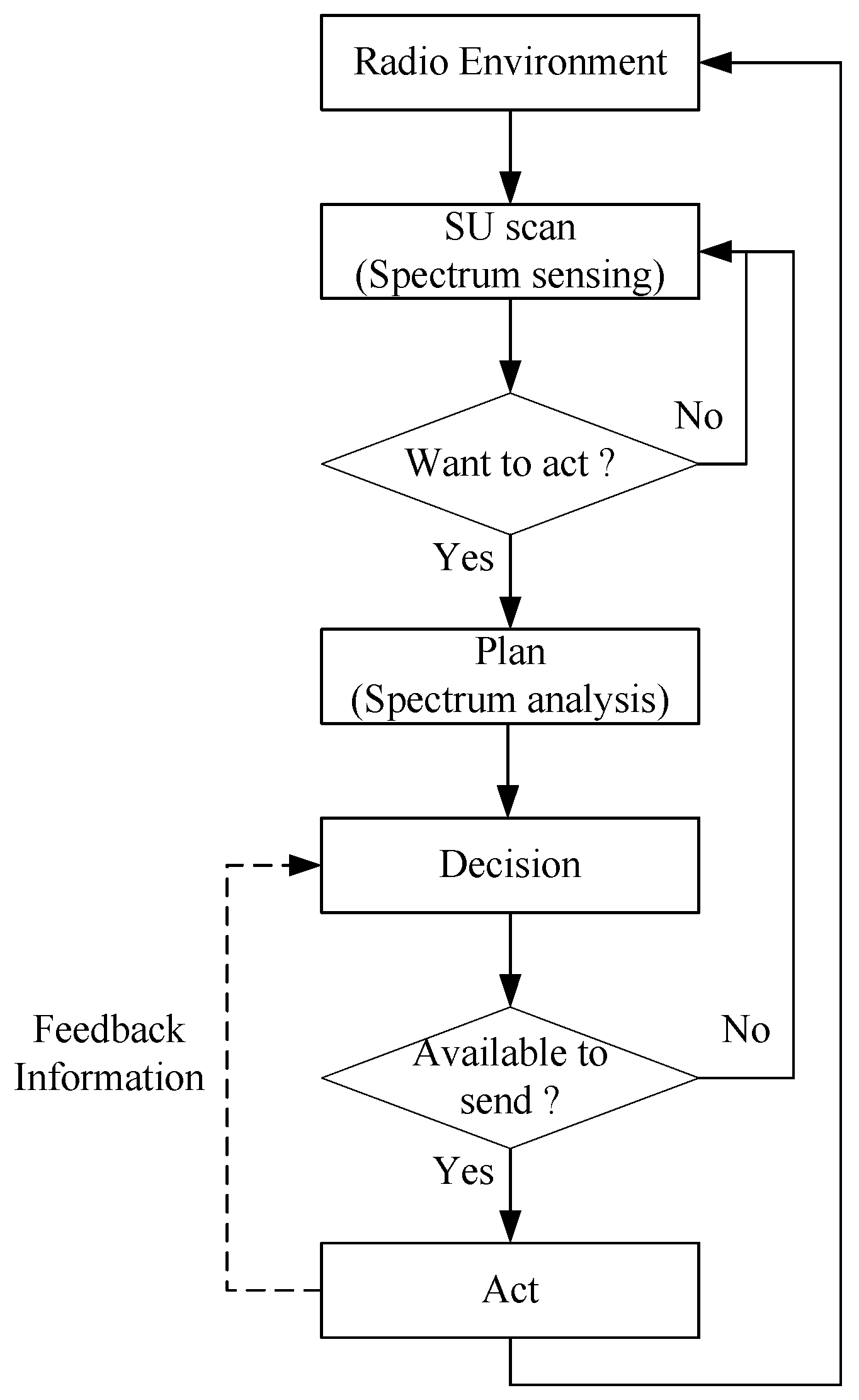
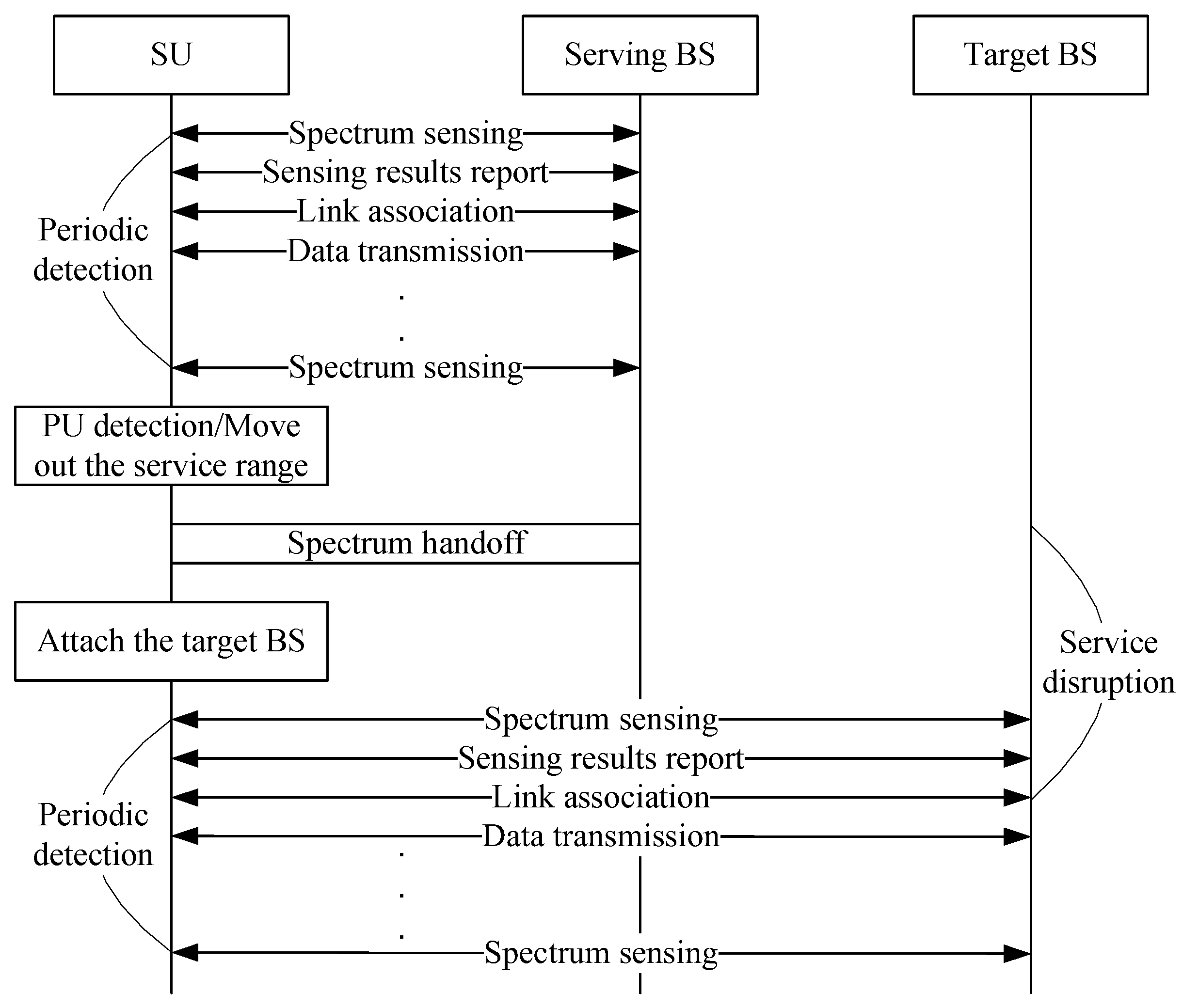


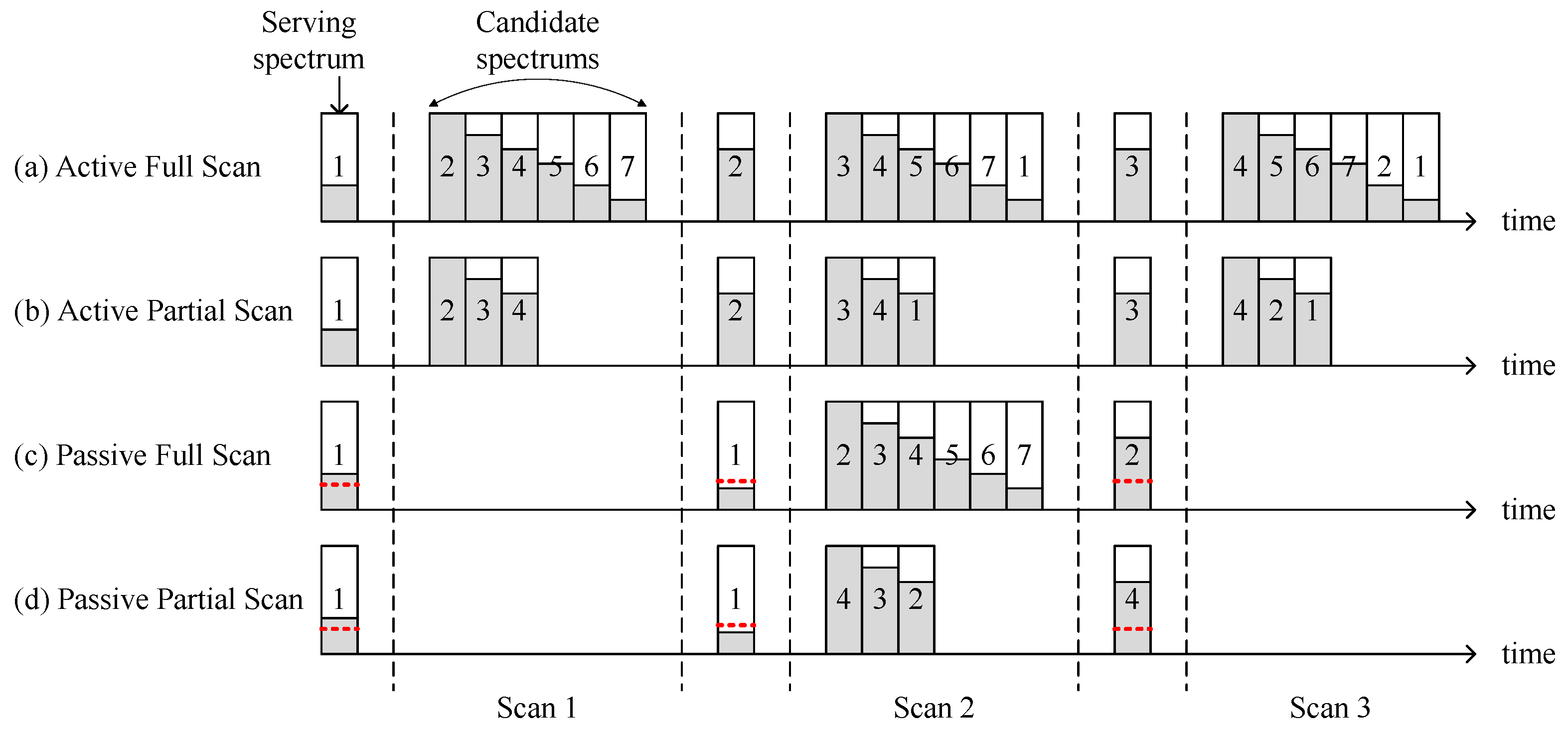
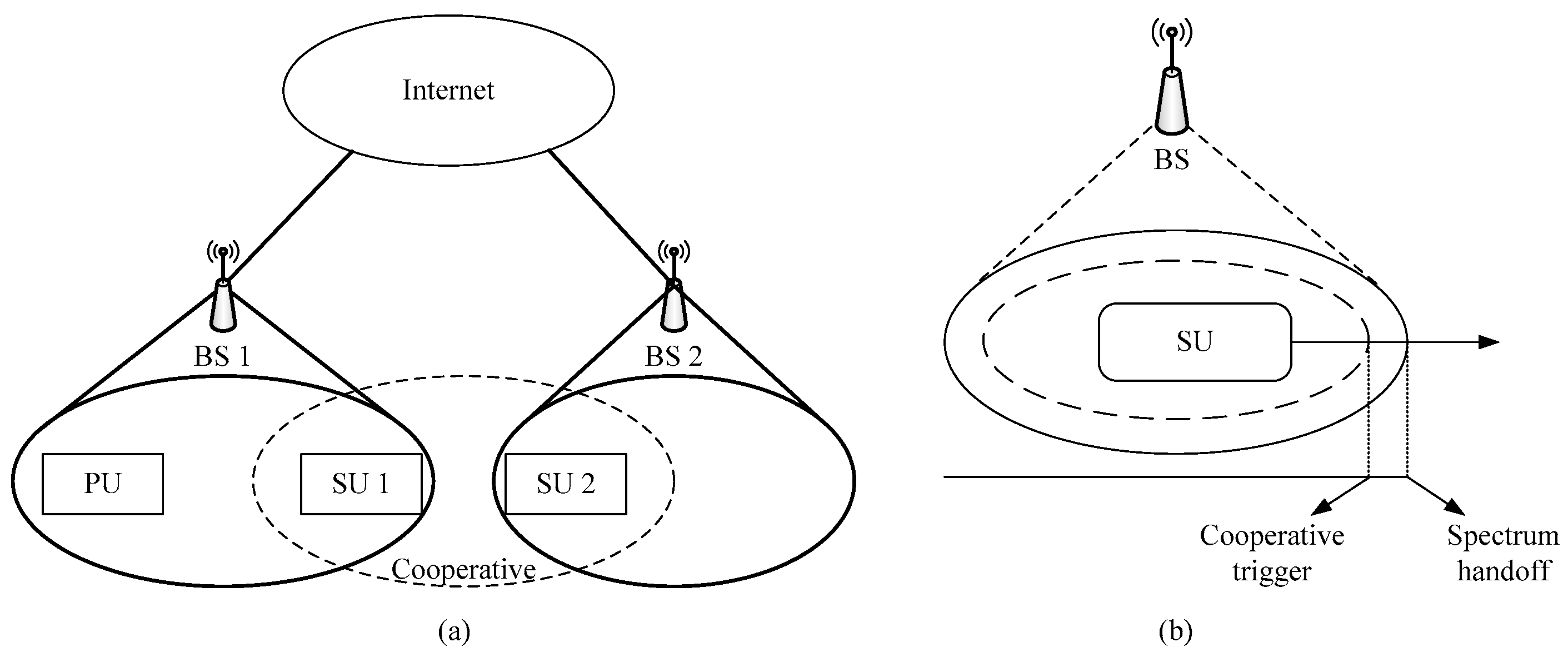
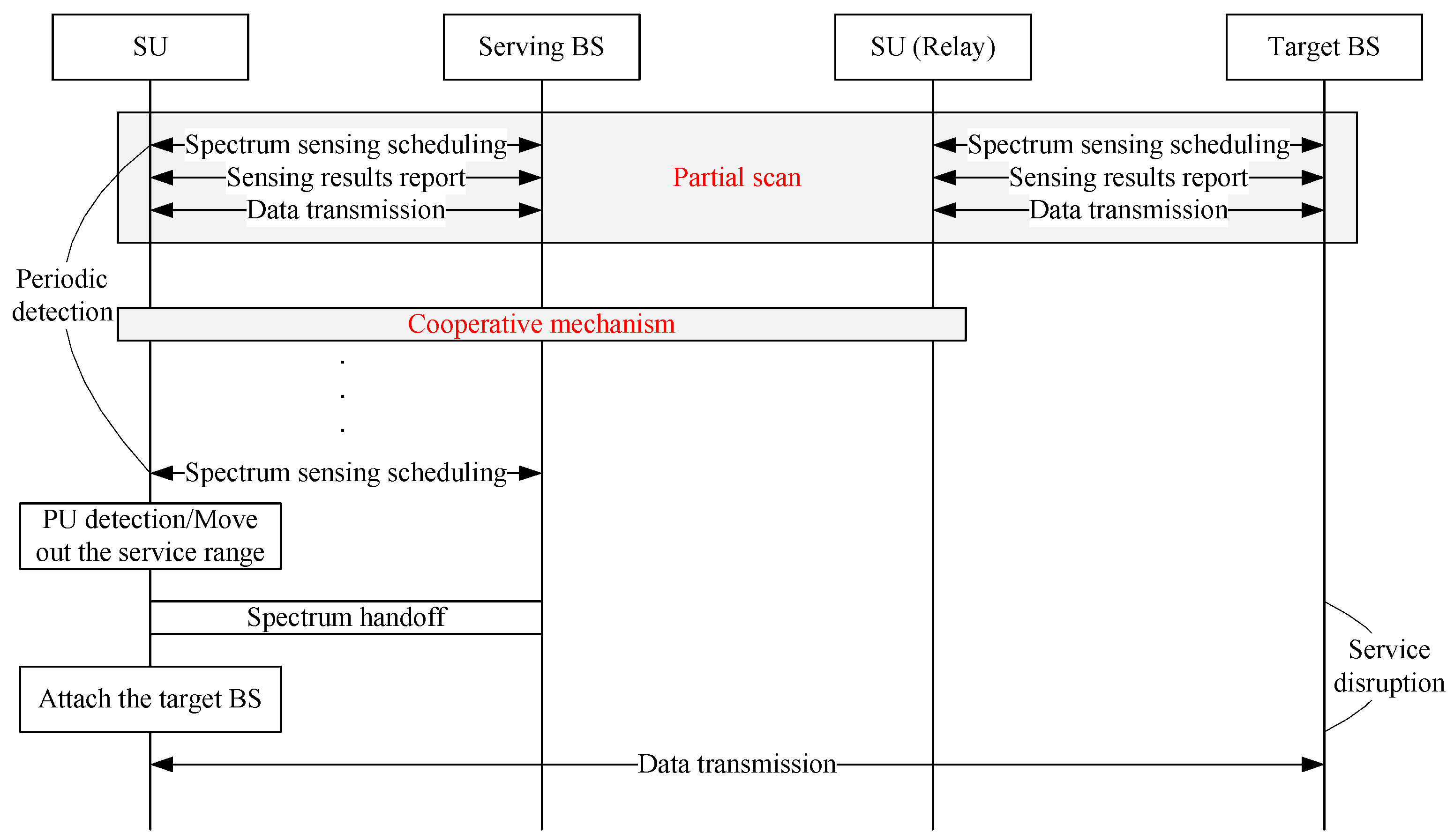
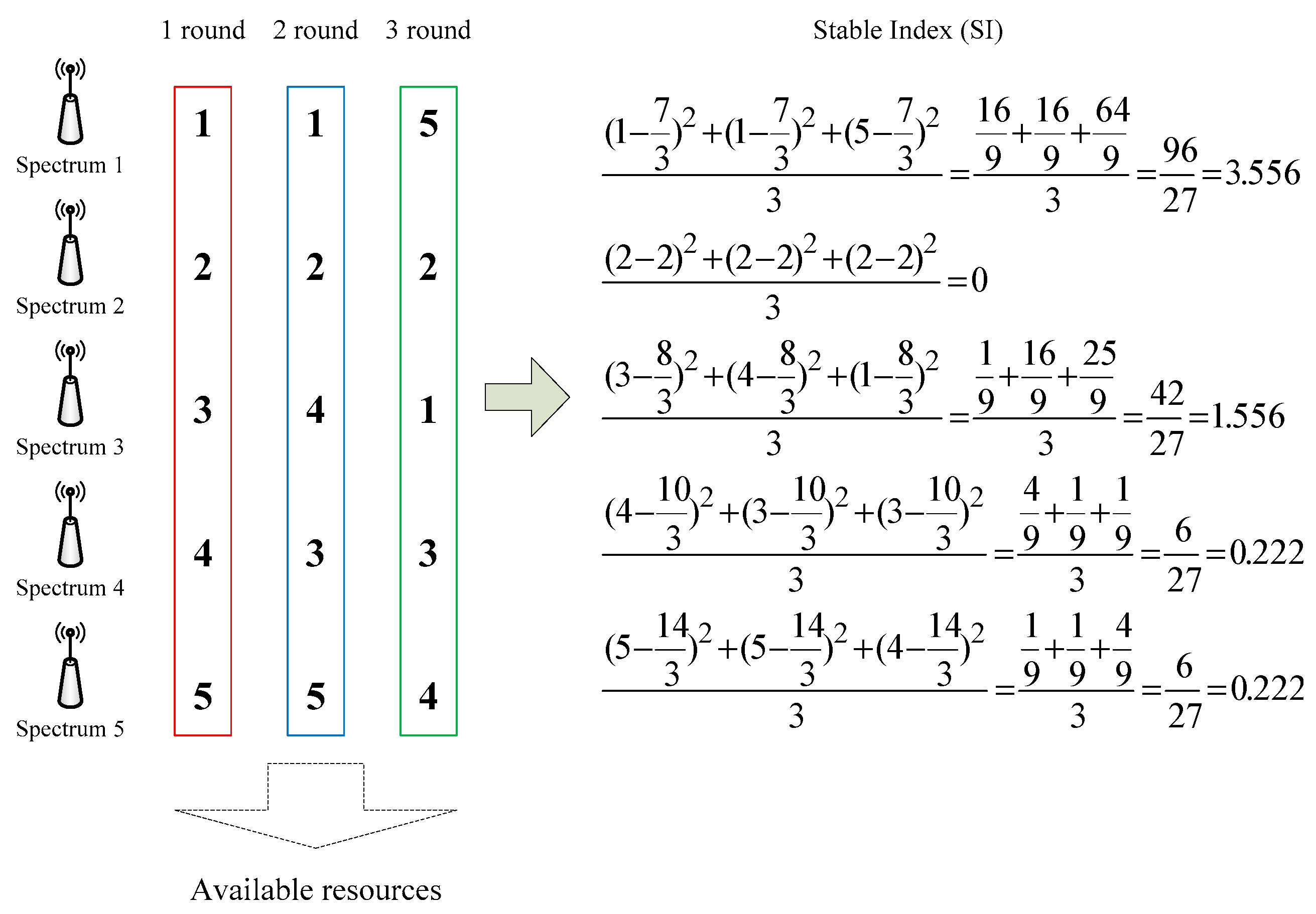
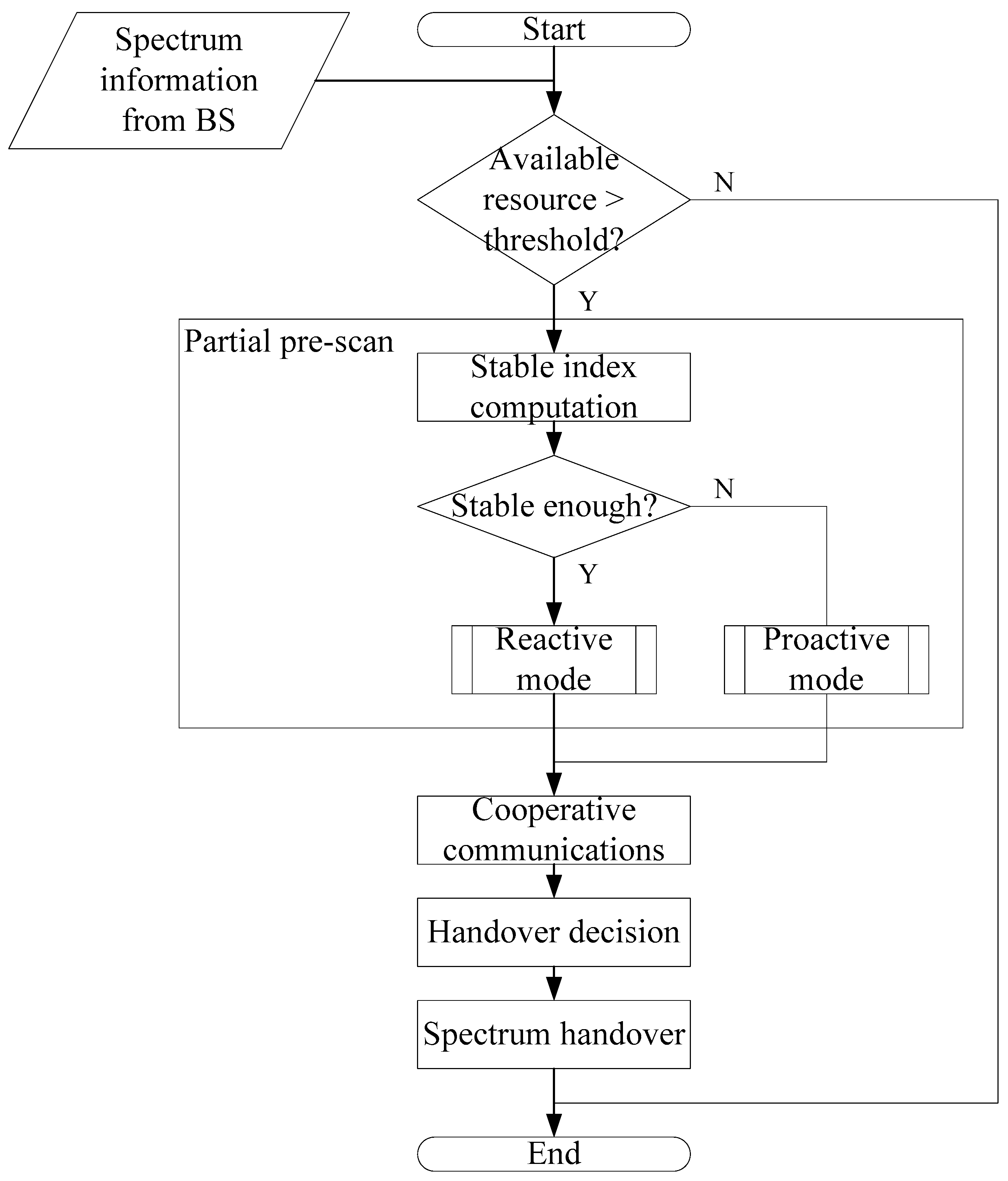

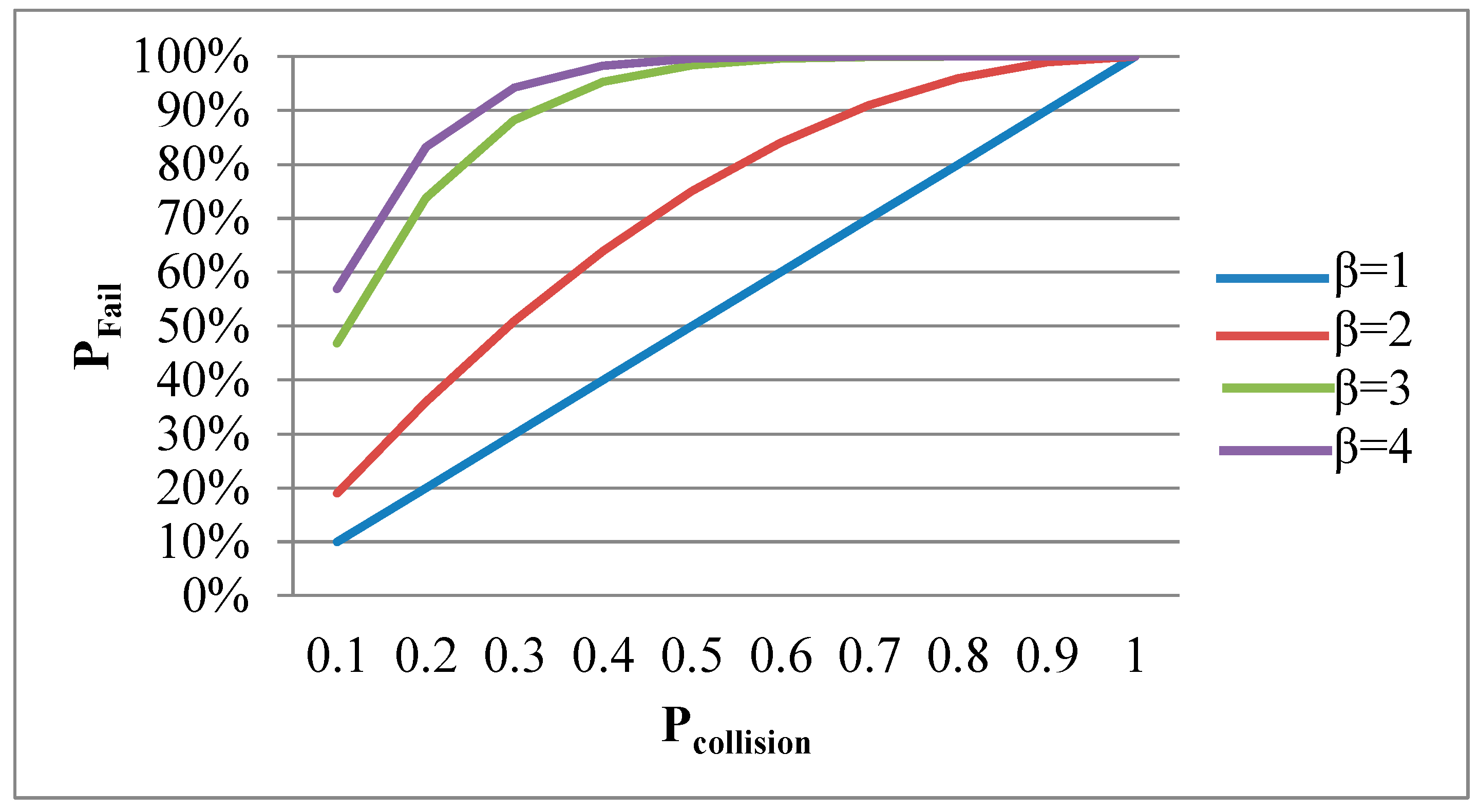
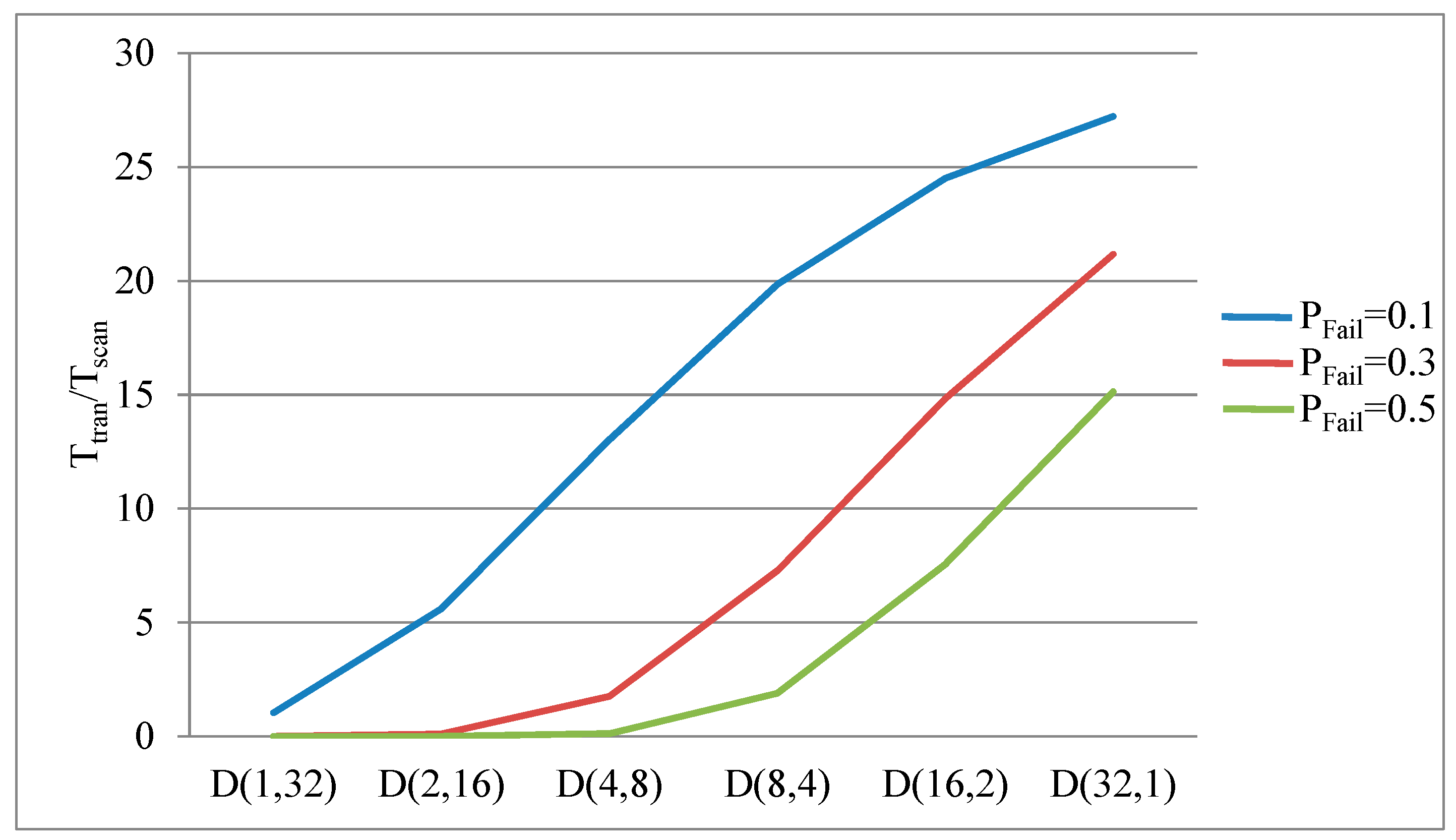
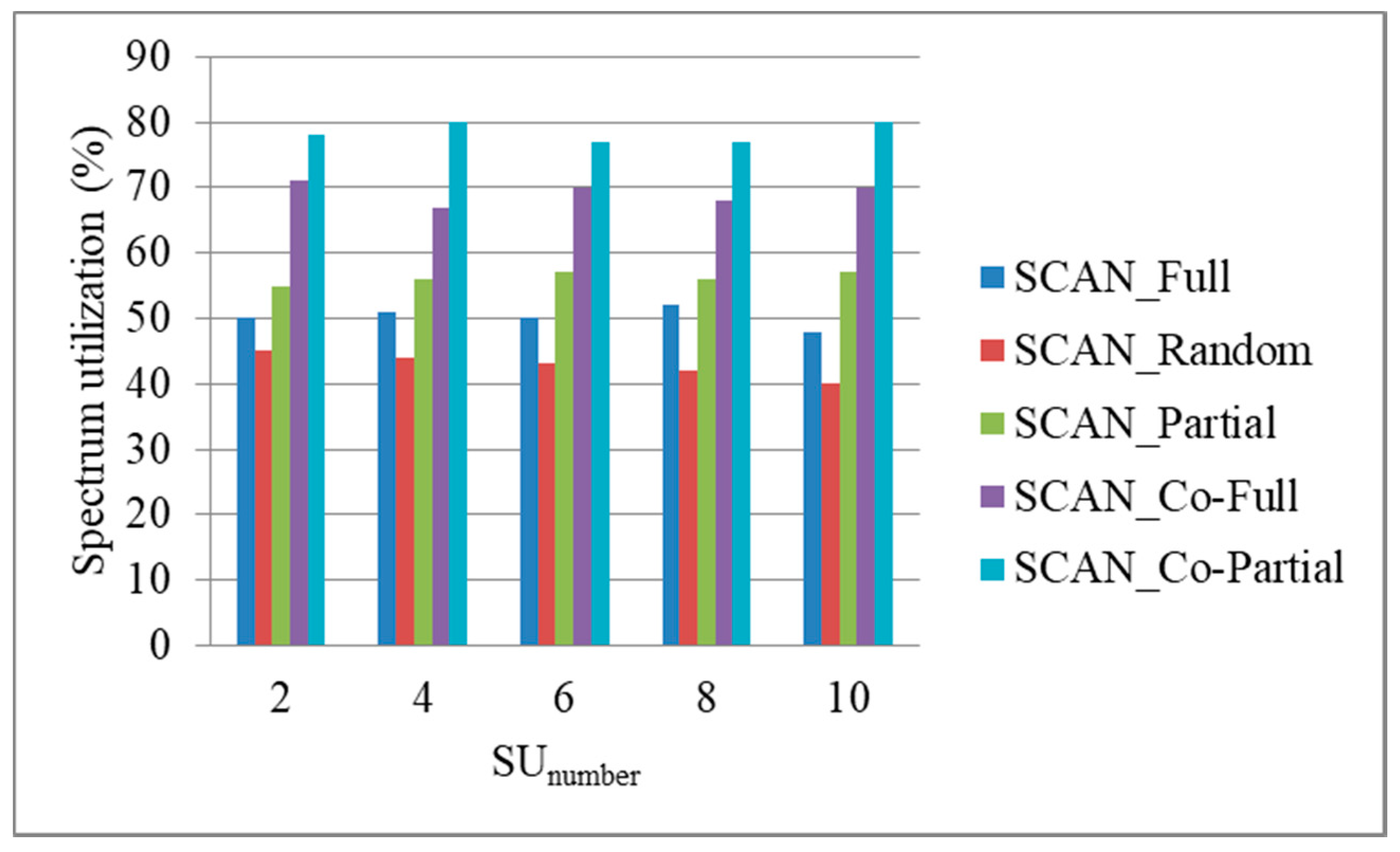
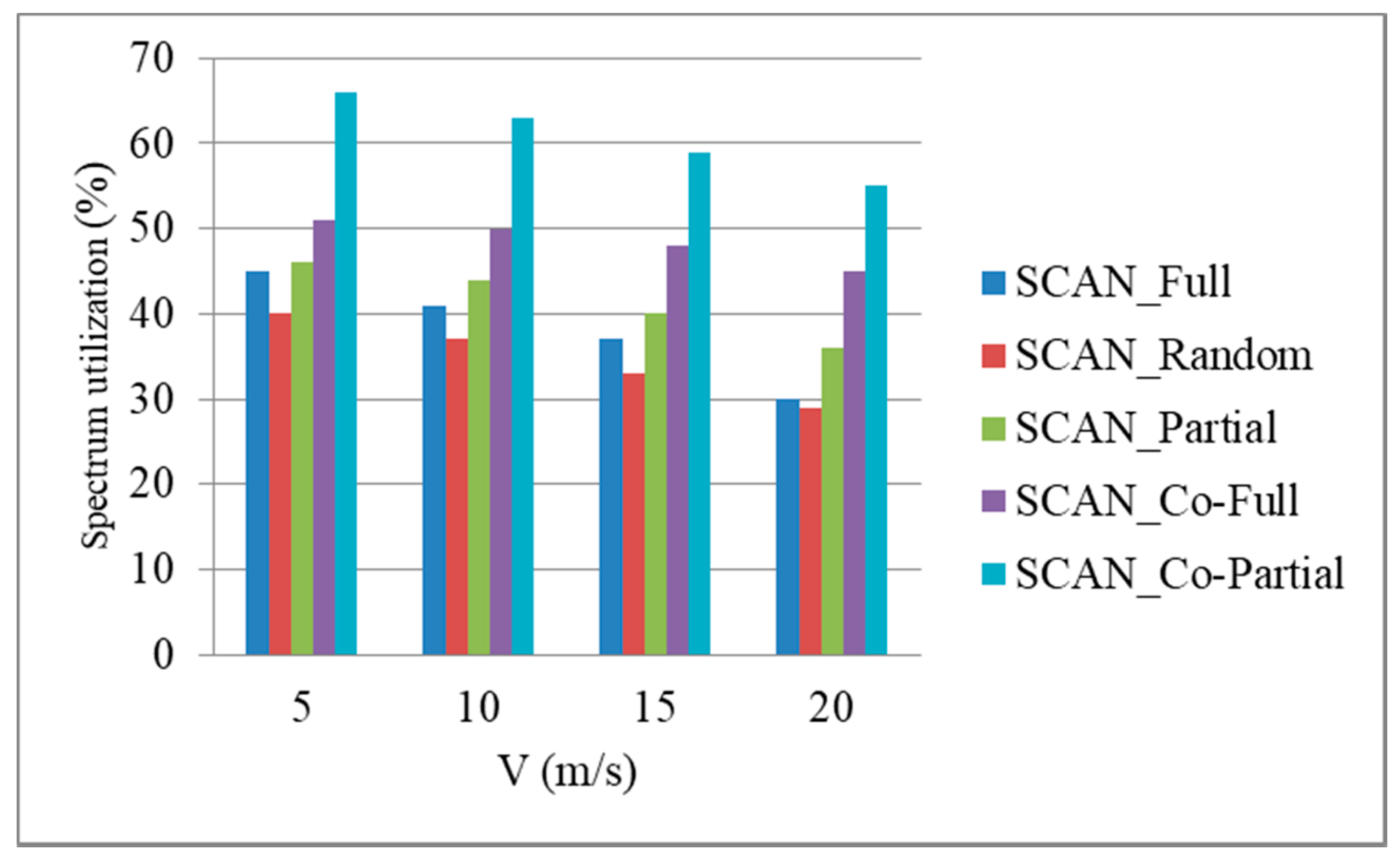







| Parameter | Value |
|---|---|
| Simulation area | 2000 × 2000 (m2) |
| Number of PU (PUnumber) | 2, 4, 6, 8, 10 |
| Probability of PU car access network (PPUaccess) | 0.3~0.8 |
| Number of SU (SUnumber) | 2, 4, 6, 8, 10 |
| Number of BS | 10 |
| Transmission range of BS | 1000 (m) |
| Mobility model | Random way point |
| Moving speed of vehicle | 5~20 (m/s) |
| Bandwidth | 100 (Mbps) |
| Simulation time | 600 (sec) |
| Number of antenna per vehicle | 2 |
| Transmission range of vehicle | 100 (m) |
| Packet size | 1500 bytes |
Publisher’s Note: MDPI stays neutral with regard to jurisdictional claims in published maps and institutional affiliations. |
© 2021 by the author. Licensee MDPI, Basel, Switzerland. This article is an open access article distributed under the terms and conditions of the Creative Commons Attribution (CC BY) license (http://creativecommons.org/licenses/by/4.0/).
Share and Cite
Chuang, M.-C. Cooperation-Assisted Spectrum Handover Mechanism in Vehicular Ad Hoc Networks. Electronics 2021, 10, 742. https://doi.org/10.3390/electronics10060742
Chuang M-C. Cooperation-Assisted Spectrum Handover Mechanism in Vehicular Ad Hoc Networks. Electronics. 2021; 10(6):742. https://doi.org/10.3390/electronics10060742
Chicago/Turabian StyleChuang, Ming-Chin. 2021. "Cooperation-Assisted Spectrum Handover Mechanism in Vehicular Ad Hoc Networks" Electronics 10, no. 6: 742. https://doi.org/10.3390/electronics10060742






